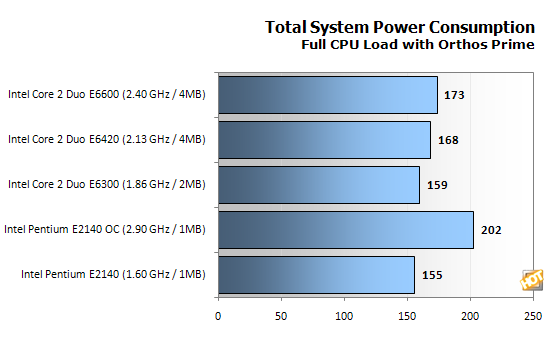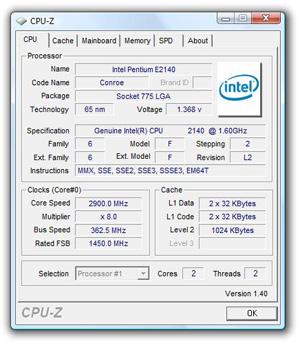Intel Pentium E2140 Dual Core Processor
Overclocking and Power Consumption
Intel ships the Pentium E2140 with a standard Socket-775 heatsink/fan cooling unit which looks identical to the Core 2 Duo cooling units we’ve seen in the past. However, since these processors don’t push the thermal limits of this heatsink design, Intel has gone for a simple aluminum alloy core instead of a full-on copper core like Core 2 bundled coolers. Beyond this fact, the cooler is the same between the two chip lines. The fan appears to be manufactured by Foxconn, which is a 4-pin PWM enabled fan which runs at very low noise levels by default.
|
Stock Cooler - Top
|
Stock Cooler - Bottom
|
We had high hopes for overclocking this chip, as rumor had it these chips could hit 3.0 GHz and beyond with some exotic cooling methods. We were curious to see how well we could do with air cooling, as we feel like this is likely more in line with what potential buyers of a $99 processor will use.
With our eVGA nForce 680i LT SLI motherboard (a terrific overclocker), we set out to push this chip as far as we could, step by step. At default voltage levels, we were able to push the chip to an impressive 2600 MHz by increasing the front side bus speed from 800 MHz to 1300 MHz. This represents a 62.5% increase in clock speed with almost no work at all - a good start.
When we started pushing the chip further, we needed to crank up the voltage levels in order to keep the chip running smooth and stable. The end result of our overclocking efforts (on air-cooling) had our processor clocked at 2900 MHz with a core voltage of 1.5V. This represents an 81% increase in clock speed with just a few changes in the BIOS. We were able to push the chip up to 2.93 GHz (the same clock speed as Intel’s fastest shipping desktop Core 2 processors) and complete some benchmarking, but it ended up being unstable over our long term tests. We’ve included benchmarks of the chip at 2900 MHz throughout the following pages for reference, however.
|
Stable Overclock - 2.9 GHz
|
Peak Overclock - 2.93 GHz
|
Power consumption was tested with C1E/EIST disabled. Idle power load levels were tested with the system sitting at the Windows desktop, whereas full processor load levels were taken with Orthos Prime 95 (dual-core CPU stress testing utility) running and both processor cores maxed out.


As you can see, in its stock configuration, the new Pentium E2410 conumses the least amount of power. While overclocked and running under a full load, its consumption is higher than the Core 2 Duo processors referenced here, but please note that the E2140 was running 500MHz+ higher than the other chips and with a slightly increased core voltage.










